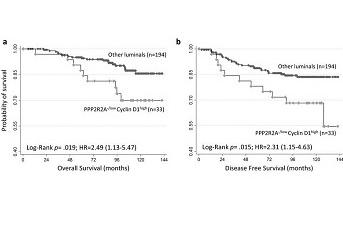Associação Portuguesa de Investigação em Cancro
Novos biomarcadores identificam carcinomas de mama de tipo luminal agressivos
Novos biomarcadores identificam carcinomas de mama de tipo luminal agressivos

Recentemente, deleções no locus contendo o gene PPP2R2A, que codifica a proteína B55α, uma subunidade regulatória da PP2A (Protein Phosphatase 2), foram associadas a um subgrupo de cancro da mama, ER (receptores de estrogénio) positivos muito agressivos. No mesmo trabalho, este subgrupo de carcinomas, denominado Integrative Custer 2, caracterizava-se ainda por amplificações de uma da região 11q13, que entre outros, contém o gene CCND1 que codifica a Ciclina D1.
Assim, este grupo de investigadores avaliou o potencial valor prognóstico da expressão da PPP2R2A (B55α) em combinação com a expressão da Ciclina D1 com o objectivo de encontrar biomarcadores rapidamente aplicáveis em ambiente clínico para a identificação deste grupo de carcinomas de tipo luminal, mas altamente agressivo. Para isso, foram utilizados 2 coortes independentes e um total de amostras de mais de 800 pacientes com cancro da mama.
Este foi o primeiro estudo a demonstrar que a combinação do fenótipo definido pela ausência de expressão da PPP2R2A (B55α) e sobre expressão de Ciclina D1 (PPP2R2A (B55α)-/low/Cyclin D1high), permite identificar um subgroupo de pacientes com cancro da mama de tipo luminal com alto risco de recidiva e morte.
Autores e Afiliações:
Francisco Beça - IPATIMUP – Institute of Molecular Pathology and Immunology of the University of Porto, Rua Dr, Roberto Frias, s/n, 4200-465 Porto, Porto, Portugal; Department of Medical Oncology, Dana-Farber Cancer Institute, 450 Brookline Ave., Boston 02215-5450, MA, USA
Miguel Pereira - Division of Surgical Oncology, Department of Surgery, Massachusetts General Hospital Cancer Center, 55 Fruit St, Boston 02114, MA, USA
Jorge F Cameselle-Teijeiro - Complexo Hospitalar Universitario de Vigo (CHUVI), Rua de Pizarro, 22, Vigo, 362004, Spain
Diana Martins - IBMC – Instituto de Biologia Molecular e Celular da Universidade do Porto, Rua do Campo Alegre, 823, Porto, 4150-180, Portugal
Fernando Schmitt - Department of Pathology and Medicine, Laboratorie National de Sante 1, Rue Louis Reche, Dudelange, L-3555, Luxembourg
Abstract:
Background: PPP2R2A deletions were recently linked to a subgroup of luminal breast carcinoma (BC) that exhibits poor survival. This subgroup also exhibited amplification of a chromosome region containing the Cyclin D1 coding gene, CCND1. Therefore, we aimed to investigate whether a combination of PPP2R2A (B55α) and Cyclin D1 expression statuses evaluated by immunohistochemistry (IHC) could define a subgroup of luminal BC that exhibits poor survival.
Methods: First we conducted a retrospective cohort study using sequencing data from The Cancer Genome Atlas initiative to correlate PPP2R2A copy number alteration (CNA) status with its expression level and the corresponding overall survival (OS). Next, also using a retrospective cohort study design, we evaluated the PPP2R2A (B55α) expression levels by IHC in a total of 807 BC patients from two independent cohorts (discovery cohort n = 349 and validation cohort n = 458). Cyclin D1 expression was also evaluated, and the PPP2R2A (B55α) /low/Cyclin D1high phenotype was evaluated as a predictor of disease-free survival (DFS) and OS in luminal-like BC patients.
Results: Deletions in the PPP2R2A gene strongly correlate with lower mRNA expression and poorer OS. PPP2R2A (B55α)-/low carcinomas have significantly shorter DFS and OS. Furthermore, in univariate analysis, the PPP2R2A (B55α)-/low/Cyclin D1high phenotype is significantly associated with poorer DFS and OS. In a multivariate analysis, the PPP2R2A (B55α)-/low/Cyclin D1high phenotype is significantly associated with poor DFS, thus defining a group of luminal-like BC with higher risk of relapse.
Conclusion: We demonstrate that BCs harboring PPP2R2A deletions are associated with worse OS. Moreover, this is the first study to demonstrate that the combination of altered PPP2R2A (B55α) and high Cyclin D1 expression by IHC defines a subgroup of luminal-like BC patients with a high risk of relapse and death.
Revista: BMC Cancer




